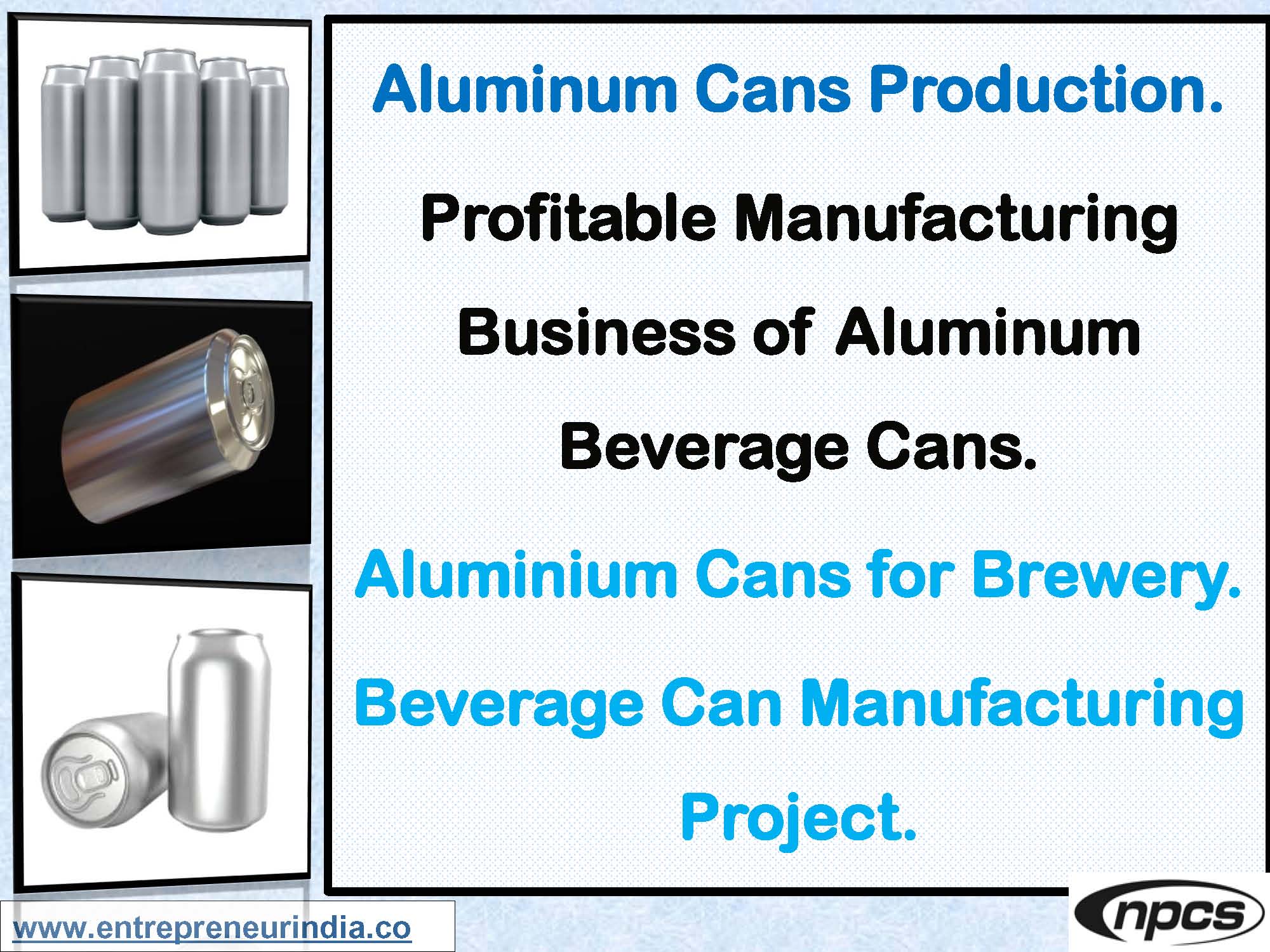
Aluminum cans have become one of the most popular and efficient packaging solutions in the beverage industry. Thanks to their lightweight nature, recyclability, and superior preservation qualities, they’re in high demand across soft drink, energy drink, and alcoholic beverage markets. If you’re planning to enter the manufacturing sector, aluminum cans production presents a high-potential, profitable manufacturing business opportunity. Moreover, as more companies transition to sustainable packaging, the demand for aluminum cans continues to rise. This makes the beverage can manufacturing project especially promising in today’s eco-conscious market.
Aluminum Cans Production. Profitable Manufacturing Business of Aluminum Beverage Cans. Aluminium Cans for Brewery. Beverage Can Manufacturing Project.
This guide will walk you through everything you need to know about setting up an aluminum can production unit—from the manufacturing process to cost structure, profit potential, and beyond.
1. Why Aluminum Cans? Understanding the Growing Demand
Aluminum cans offer numerous advantages over glass or plastic. For instance, they chill beverages faster, are easier to stack and transport, and offer better shelf-life. More importantly, they are 100% recyclable—making them a sustainable choice.
In addition, beverage brands are shifting to aluminum packaging to meet environmental regulations and consumer expectations. As a result, the global and domestic demand for aluminum beverage cans has surged.
Also Read – Want to Start a Business in Madhya Pradesh
2. Market Potential and Industry Trends
India’s beverage packaging industry is expanding rapidly. Specifically, the aluminum can segment is expected to grow at a CAGR of 6–8% over the next five years. This growth is driven largely by rising demand in both alcoholic and non-alcoholic drink markets.
Notably, global brands such as Coca-Cola, PepsiCo, and Anheuser-Busch are pushing more of their product lines into cans. Likewise, smaller regional beverage brands are adopting this format to appeal to eco-conscious consumers.
3. Types of Aluminum Cans Used in Beverages
Aluminum cans typically fall into two categories. Understanding the differences will help you choose the right production model.
A. Two-Piece Cans
These are formed from a single sheet of aluminum and include the body and base as one continuous unit. The lid is then sealed separately. Two-piece cans are the most common in the beverage industry due to their efficiency and durability.
B. Three-Piece Cans
These consist of a separate body, top, and bottom. Although they are more common in food packaging, some specialty beverages use this type. However, they are generally less efficient to manufacture.
Therefore, for mass production of beverage cans, the two-piece design is the most practical and cost-effective.
4. The Manufacturing Process Explained
Aluminum can manufacturing is a precise and technical process. Nevertheless, with the right equipment and setup, it can be streamlined efficiently.
Steps Involved:
-
Blanking and Drawing
First, aluminum coils are fed into a press that cuts circular blanks and draws them into shallow cups. -
Redrawing and Ironing
These cups are then stretched and thinned to form the cylindrical body of the can. -
Trimming
Excess metal at the top is trimmed to ensure uniform height. -
Cleaning and Drying
The cans are cleaned thoroughly to remove lubricants and particles, followed by drying. -
Printing and Coating
Next, cans are printed with brand designs and coated internally to prevent metal-leach reactions with the beverage. -
Necking and Flanging
The top is narrowed to fit the lid, which improves strength and stackability. -
Seaming the Lid
Finally, the lid is attached and sealed to complete the can.
Altogether, this process ensures that the final product is durable, attractive, and safe for beverage storage.
5. Setting Up Your Manufacturing Unit
Before diving in, you must consider your plant’s location, layout, and equipment.
A. Land and Infrastructure
You’ll need 25,000 to 40,000 sq. ft. of industrial space with adequate utilities like electricity, water, and drainage.
B. Machinery Requirements
Depending on your scale, you will need:
-
Coil unwinder and blanking press
-
Drawing and ironing machines
-
Washing and drying units
-
Offset printing machines
-
Necking, flanging, and seaming machines
Although the initial investment is high, the output efficiency and longevity of the equipment make it worthwhile.
6. Raw Materials Required
The primary raw material is aluminum alloy sheets (typically 3104 H19 grade). Additionally, you’ll need:
-
Coating lacquers
-
Printing inks
-
Aluminum ends/lids with pull tabs
-
Cartons or shrink films for packaging
Importantly, sourcing high-quality aluminum will impact the durability and finish of your cans.
7. Investment and Cost Structure
The cost of setting up a beverage can manufacturing project can vary based on capacity and automation level.
| Component | Estimated Cost (INR) |
|---|---|
| Land & Infrastructure | ?1.5 – ?2.5 crore |
| Machinery & Equipment | ?3 – ?5 crore |
| Utilities (power/water) | ?30 lakh |
| Raw Materials | ?50 – ?70 lakh |
| Labor & Admin | ?20 lakh |
| Licensing & Compliance | ?5 – ?10 lakh |
| Total Estimated Investment | ?6 – ?9 crore |
While these figures may seem steep, the returns can be significant with consistent production and long-term contracts.
8. Legal Approvals and Compliance
To operate legally, you’ll need to secure:
-
MSME/Udyam Registration
-
Factory License
-
Pollution Control Board NOC
-
BIS Certification (recommended)
-
GST Registration
Additionally, if you plan to import raw materials or export finished cans, an IEC (Import Export Code) is essential.
9. Target Customers and Distribution Channels
Your ideal clients include:
-
Soft drink and beer companies
-
Fruit juice manufacturers
-
Energy drink brands
-
Ready-to-drink coffee/tea producers
-
Beverage exporters
Moreover, by offering custom branding and bulk order discounts, you can attract contract packaging deals with private-label brands.
10. Profitability and ROI
When scaled efficiently, this business yields healthy profit margins.
-
Cost per Can (including materials & overheads): ?2.50–?3.50
-
Wholesale Selling Price: ?4.00–?5.50
-
Gross Margin: 30–40%
With consistent demand and smart supply chain management, most manufacturers reach break-even within 3 to 4 years.
11. Sustainability and Long-Term Outlook
Unlike plastic, aluminum is infinitely recyclable. In fact, over 75% of all aluminum ever produced is still in use. Consequently, government policies, global brands, and consumers are increasingly favoring aluminum over other packaging materials.
Furthermore, India’s growing beverage industry and government initiatives on sustainable packaging create the perfect environment for long-term business success.
See More – Fruit Juice Processing Plant
Conclusion
In summary, aluminum cans production is a highly promising and future-ready business. With rising demand from breweries, beverage companies, and eco-conscious consumers, it offers a unique blend of profitability and sustainability. By investing in the right technology, maintaining product quality, and establishing strategic partnerships, your beverage can manufacturing project can thrive in India’s expanding market.
If you’re ready to explore this profitable manufacturing business, now is the ideal time to make a move.





